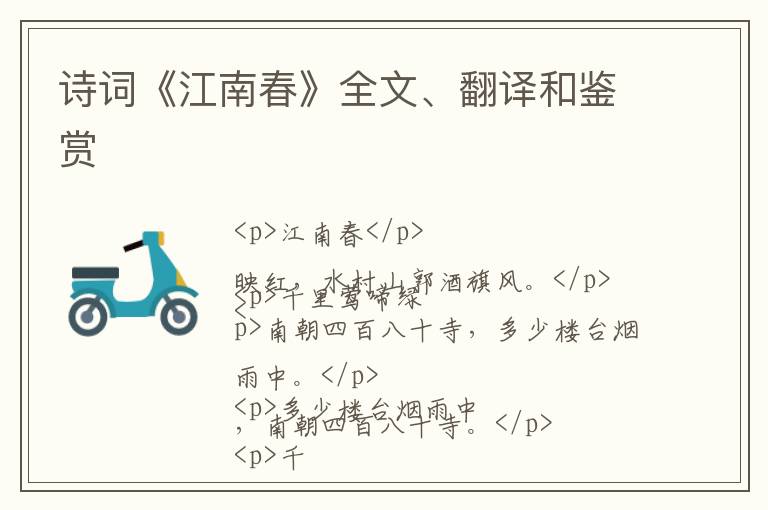诗词《江南春》全文、翻译和鉴赏

江南春
千里莺啼绿映红,水村山郭酒旗风。
南朝四百八十寺,多少楼台烟雨中。
多少楼台烟雨中,南朝四百八十寺。
千里莺啼绿映红,水村山郭酒旗风。
Translation:
Spring in the South
A thousand miles of warblers sing, green echoes red,
Villages and towns adorned with wind-blown tavern flags.
Four hundred and eighty temples of the Southern Dynasty,
How many tower pavilions amidst the misty rain.
How many tower pavilions amidst the misty rain,
Four hundred and eighty temples of the Southern Dynasty.
A thousand miles of warblers sing, green echoes red,
Villages and towns adorned with wind-blown tavern flags.
Appreciation:
In this poem, the poet captures the vibrant scenery and cultural heritage of the southern region of China during the spring season. The opening lines depict the beauty of nature with warblers singing amidst a backdrop of lush greenery and red flowers. The following lines paint a picture of water villages, mountains, and the lively atmosphere created by swaying tavern flags.
The latter half of the poem introduces the historical and poetic element, mentioning the numerous temples and tower pavilions of the Southern Dynasty. The poet muses about the countless structures that stand tall amidst the misty rain, symbolizing the rich historical and architectural heritage of the region.
Overall, "Spring in the South" portrays the harmonious coexistence of nature, human life, and cultural heritage in the southern region of China, showcasing the poetic beauty of this enchanting landscape.
杜 牧
千里莺啼绿映红,水村山郭酒旗风。
南朝四百八十寺,多少楼台烟雨中。
【原诗今译】
千里绿树映红花,千里莺儿叫,
水乡和山城,酒旗如画猎猎飘,
看哪,南朝的四百八十座寺庙,
多少楼台哟,此刻茫茫烟雨罩。
【鉴赏提示】
这是一首画面优美、引人入胜的佳作。诗人以辽阔的江南为背景,运用了典型化的手法,对江南景物的特征作了高度的概括和形象的描绘,因而全诗犹如一幅清新而妍丽,广阔而幽远的江南水乡春色图。
“千里莺啼绿映红,水村山郭酒旗风。”诗人起句即把视野扩展开去,从大处着笔,渲染出千里江南,处处黄莺啼鸣,万物绿红相映的盎然春意。那座座流水环绕的村庄,依山凭势的城郭,随风飘扬的酒旗,给秀丽的江南大地更增添了勃勃生机。诗人笔下的黄莺、红花、绿叶、水村、山郭、酒旗,不是江南某一处山野名胜或园林景致。开头“千里”二字即点明,他是以尺幅之素绘江南千里春色,从而勾勒出锦绣江南的整体特色。这正表现出诗人非凡的艺术匠心和高度的概括能力。但是,明代的杨慎在升庵诗话中却谓:“千里莺啼,谁人听得?千里绿映红,谁人见得?若作十里,则莺啼绿红之景,村郭、楼台、僧寺、酒旗皆在其中矣。”实际上,正如清人何文焕所言:“即在十里,亦未必尽听得着看得见。题云江南春,江南方广千里,千里之中莺啼而绿映红焉,水村山郭无处无酒旗,四百八十寺楼台多在烟雨中也。此诗之意既广,不得专指一处,故总而题曰江南春,诗家善立题者也。”(历代诗话考索)就诗的艺术表现手法而言,它是艺术概括的产物。诗人写景状物,自不必实录于所见,拘泥于所闻,既可写眼前景,又可写意中景,亦可二者相揉。诗人在这里即把实感与意象结而为一,以大写意的手法为我们描绘出了一幅地域广阔、物态万千的江南春景图。
江南春景除了明朗秀丽外,还表现在烟雨迷濛。“南朝四百八十寺,多少楼台烟雨中。”诗人又以干湿浓淡的笔墨,在千里江南图上描绘出了阴晴雨雾变化的特征。濛濛的雨丝,给那一座座、一处处庙宇楼台,渲染上一层烟雾迷濛的色彩,为整个画面增添了朦胧之美。这色彩与上二句中描写的明媚春色形成了极大反差,从而使整个画面明暗错综,层次更叠,富有变化,生动、真实地写出了千里江南妩媚的情韵。
前后两种景色的对比,不仅完整了画面,而且也从色彩的对比中映衬出诗人的咏史思想。细细体察“多少楼台烟雨中”一句,此中正蕴含着深深的感叹:二、三百年前建起的“四百八十寺”,随南朝的覆灭、历史的演进和风雨的侵蚀,倒的倒了,毁的毁了,现存的还有多少呢?那显赫一时的荣华富贵又到哪里去了呢?
这首小诗写景抒情辞微意远,状物绘像清灵活泼,显示了小杜诗歌意境清新、情味隽永的艺术特色。

